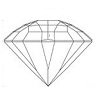16.45: Kyanite
- Page ID
- 4732
| Kyanite | |
|---|---|
| Chemical composition | Aluminum Silicate Al2Si05 |
| Crystal system | Triclinic |
| Habit | Elongated bladed or columnar. |
| Cleavage | Perfect and good/uneven |
| Fracture | Uneven |
| Hardness | 4 - 7.5 |
| Optic nature | Biaxial - |
| Refractive index | 1.710- 1.734 |
| Birefringence | 0.017 |
| Dispersion | 0.020 |
| Specific gravity | 3.65 - 3.68 |
| Lustre | Vitreous |
| Pleochroism | Moderate to Strong, Trichroic |

Figure \(\PageIndex{1}\): Faceted Kyanite
Photo courtesy of The Gem Trader
Kyanite is an aluminum silicate with the chemical formula Al2SiO5. Its name derives from the Greek word "kyanos" which means blue.
The color is blue to colorless, blue-green and brown with a vitreous luster.
Kyanite together with andalusite and sillimanite, all gemstones, belongs to the same polymorphic family. All are isolated tetrahedral silicates and have the same chemical formula but have distinctly different structures.
Kyanite is a metamorphic mineral that occurs in schists, gneisses and granite pegmatites. Associated minerals are quartz, feldspar, mica, garnet, corundum, and staurolite.
Kyanite occurs as bladed and tabular triclinic crystals. Lamellar twinning is common. It has two cleavage directions, one perfect and the other one good-uneven. It has directional hardness with 4 in the direction of the c-axis and 7.5 in right angles to the c-axis.
Localities: Brazil, Kenya, Mocambique, Norway, Myanmar, Austria, Switzerland etc.
Synonyms: Cyanite, Disthene.
Diagnostics
Kyanite may be confused with:
Diaphaneity
Transparent to translucent.
Color
Kyanite is allochromatic and occurs in the colors blue to colorless, blue-green, brown and orange.
The blue variety is the most used as a gemstone.
The cause of color is iron and titanium for blue stones (charge transfer from Fe2+ --> Ti4+) and vanadium for green ones. Orange stones are probably colored by iron and/or manganese.
Hardness
Kyanite has directional hardness with 4 to 5.5 in the direction of the c-axis and 7 to 7.5 at right angles to the c-axis.
Cleavage
Kyantite has perfect cleavage along one prism direction {100} and good cleavage along the {010} plane. It also has basal parting {001}.
Streak
White.
Refractometer
nα = 1.710 - 1.718, nβ = 1.719 - 1.724, nγ = 1.724 - 1.734 with a birefringence of 0.012 to 0.017.
Optical nature: biaxial negative.
Pleochroism
Moderate to strong (weak in orange stones).
Blue stones: colorless, blue, dark blue.
Luminescence
LW-UV: weak red.
Spectroscope

Figure \(\PageIndex{2}\): Spectrum of green and some blue kyanite
Blue kyanite may show two lines in the blue with a general cut-off in the violet. Other lines in the red and deep red may be seen in bluish green kyanite.
Absorption lines: (706), (689), (671), (652), 445, 435.
Notice that the image resembles the "450 complex" of iron-rich sapphire. In this image, the 445 and 435 nm lines are shown as well as the cut-off in the violet.
For orange stones, there can be a line at 553 and a general absorption in the blue-green/blue.
Specific Gravity
Kyanite can have a specific gravity from 3.53 to 3.68, but for gem material it is usually in the higher 3.67 region. It sinks in all common heavy liquids.
Magnification
- Strong color-zoning
- Parallel needles
- Liquid feathers
Durability
Due to its perfect to good cleavage along the {100} and {010} prism planes, the stone should be protected from being knocked in the direction of the prism faces. It also shows good parting along the basal {001} plane.
In addition, the relative hardness of 4-5.5 in the direction of the prism faces makes it an even less candidate to be set in jewelry pieces that are prone to abrasion, as rings.
Phenomena
Chatoyancy is reported, but rare.
Sources
- Gems Their Sources, Descriptions and Identification 4th Edition (1990) - Robert Webster (6th ed.)
- Gemstones of the world, 3rd Rev Exp edition (2006) - Walter Schuman ISBN 1402740166
- Mineralogy second edition (2002) - Dexter Perkins ISBN 0130620998
- Gem Reference Guide (1995) - GIA ISBN 0873110196
- FlashData #25: Kyanite orange Tanzanie - J.-M. Arlabosse, 2008


